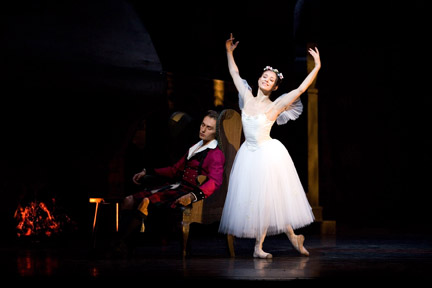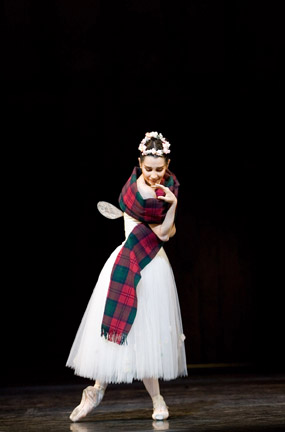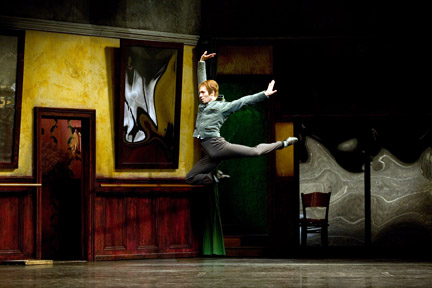“La Sylphide”, “The Lesson”, “Les Rendezvous”
The Royal Ballet
Royal Opera House, Covent Garden, London
6 October – 9 November 2005
by John Percival
copyright ©2005 by John Percival
 My generation grew up, all those years ago, thinking that The Old Classics surviving comprised the five that Ninette de Valois had presciently obtained for her company: the three Tchaikovskys plus “Giselle” and “Coppelia”. And she showed good judgment: those have remained the ones most likely to reach a wide public. But in the subsequent 50 or 60 years it has been possible with assiduity to observe some three or four times as many golden oldies, and it was “La Sylphide” that led the way, starting (unlikely as it might seem) with a production by Victor Gsovsky to the original Schneitzhoeffer music for Roland Petit’s progressive Ballets des Champs-Elysées—not claiming historical authenticity, but blessed with such ballerinas as Nina Vyroubova and Tatiana Riabouchinska in the title part.
My generation grew up, all those years ago, thinking that The Old Classics surviving comprised the five that Ninette de Valois had presciently obtained for her company: the three Tchaikovskys plus “Giselle” and “Coppelia”. And she showed good judgment: those have remained the ones most likely to reach a wide public. But in the subsequent 50 or 60 years it has been possible with assiduity to observe some three or four times as many golden oldies, and it was “La Sylphide” that led the way, starting (unlikely as it might seem) with a production by Victor Gsovsky to the original Schneitzhoeffer music for Roland Petit’s progressive Ballets des Champs-Elysées—not claiming historical authenticity, but blessed with such ballerinas as Nina Vyroubova and Tatiana Riabouchinska in the title part.
In due course “La Sylphide” became the first Bournonville ballet given by the Royal Danes at Covent Garden in August 1953 (and by then it had been revived by five ballet masters since the choreographer’s death; even more have mounted it since). There was an unmatched cast in 1953: Margrethe Schanne, amazingly light, and touchingly expressive too; Erik Bruhn with his wonderful style and technical perfection; and a terrifying Madge in the great dance actress Gerda Karstens. Enthused, since then I have sought out many productions by different companies, and among them two for British companies stand high in the memory: by Elsa Marianne von Rosen for Ballet Rambert in 1960 (seen again recently on film) and by Hans Brenaa for Scottish Ballet in 1973 (Fernando Bujones and Gyula Harangozó junior appeared as guests). Peter Schaufuss’s staging for Festival Ballet had too many adaptations for my liking, and an announced production for the (British) Royal Ballet in the 1970s didn’t happen.
So now we have it at last for that company; director Monica Mason says that the 200th anniversary of Bournonville’s birth is the perfect moment to stage one of his best-known works and that she is delighted that her Danish-born principal dancer felt able to accept her invitation to create his own production. The programme credits Kobborg with production, additional choreography and, assisted by Sorella Englund, staging. What he has chiefly added is (1) a mime scene early in Act 1, after the Sylph’s disappearance up the chimney, of James waking two men and asking whether they saw her— how could they, being asleep? But now they tell the newly arrived Gurn, who loves James’s betrothed Effie, that James is also interested in another woman. This is apparently adapted from a long-abandoned episode in Bournonville’s original. (2) some extra dancing for James and Effie in Act 1, and an irrelevant pas de six – 3 women, 3 chaps – described as Effie’s friends; that’s the bit I especially dislike, although performed with enthusiastic attack. (3) some extra dancing for James and the Sylph in Act 2. Ole Nørlyng (who also worked on Schaufuss’s version) found music for these which had been dropped over the years, and sometimes transposed it from one act to the other. We’ve been told by some reviewers how like true Bournonville the additions are; to which my reply is that using his steps isn’t enough if you haven’t also his ear for music and his style.
 Actually the whole production has been praised as very authentic, but some of those praising it have only a limited acquaintance with the real thing. To me it seems more an approximation. But maybe that’s how they dance in Denmark now; I used to go a lot, but not lately. And it is clear that Kobborg has thought about the ballet, even if I don’t agree with his findings. There’s only one big error I’d mention, and that’s not Kobborg’s but comes from the Copenhagen production he grew up with, namely letting James support the Sylph at the end of the Act 2 “divertissement”. That’s wrong after she has spent so much energy evading his potentially fatal grasp, and von Rosen’s versions (which Schaufuss followed) showed that she can balance in front of him without being held. Easy to rectify.
Actually the whole production has been praised as very authentic, but some of those praising it have only a limited acquaintance with the real thing. To me it seems more an approximation. But maybe that’s how they dance in Denmark now; I used to go a lot, but not lately. And it is clear that Kobborg has thought about the ballet, even if I don’t agree with his findings. There’s only one big error I’d mention, and that’s not Kobborg’s but comes from the Copenhagen production he grew up with, namely letting James support the Sylph at the end of the Act 2 “divertissement”. That’s wrong after she has spent so much energy evading his potentially fatal grasp, and von Rosen’s versions (which Schaufuss followed) showed that she can balance in front of him without being held. Easy to rectify.
I wish there weren’t so many different tartans among Henrik Bloch’s costumes, but Søren Frandsen’s settings are apt and attractive, especially the woodland glade for act 2. These designs, incidentally, are the ones used until recently in Copenhagen, and were commissioned in 1967 by Flemming Flindt. Kobborg told me that using them was a help because of having performed in them so often. A new costume touch is Madge lifting her skirt to reveal tarlatan underskirts—so is she a disgraced sylph?
We have had three casts so far (one and a half still to come) and I saw each at their first appearance. By far the best leading couple, to my mind, were Tamara Rojo (who had done it some years ago, very young, with Scottish Ballet, where Sorella Englund worked intensively with her) and Rupert Pennefather. They had the benefit of being coached by Johnny Eliasen, Danish and a guest teacher with the RB season, and it showed in their superior grasp of style and meticulous grasp of detail. At the premiere, Alina Cojocaru’s Sylph had been a bit wispy, and Ivan Putrov was no help as James, seeming most concerned to show his profile and his high jumps. Sarah Lamb offered some pretty moments of dance or mime as Sylph, but Federico Bonelli’s James lacked passion and he was hampered by an ill-fitting costume.
Sorella Englund’s unusually smiley Madge is as good as we remembered, perhaps even better, but Elizabeth McGorian offered only a feeble imitation of her, while Gary Avis invented a slightly odd interpretation (finally upset at having beaten James!) and looked wrong anyway, being so much taller than Bonelli. Performances in lesser roles proved variable. José Martin was the best Gurn, for dancing (he and James do the first-act solos) as well as acting. Caroline Duprot and Laura Morera both made Effie suitably sweet, and Belinda Hatley led her ensemble of sylphs very nicely.
Monica Mason, we are told, had been impressed by Kobborg’s staging of “The Lesson” in a show he put on at the Queen Elizabeth Hall two years ago, “Out of Denmark”, and therefore had it mounted to open the programme with “La Sylphide”. This time the choreographer, Flemming Flindt, came to oversee it; he has made a few small changes to the action, I think, but with no distortion; he and Tina Sander are credited with the new costumes, and he has also done the set design after Bernard Daydé’s original. Kobborg again danced the premiere; personally I find his performance lacking authority; I’ve seen many others make more of it. But I liked tiny Roberta Marquez as the wildly enthusiastic pupil. Zenaida Yanowsky was OK but not great as the bossy pianist. There’s another cast still to come.
 “The Lesson” is being given at only six performances (some papers have said it’s unsuitable for children and therefore for matinees—what rubbish!). At the other seven performances (only two of them matinees), it is replaced by “Les Rendezvous”. This is one of Frederick Ashton’s most charming all-dance ballets, created in 1933 to display the prodigious talents of Alicia Markova and Stanislas Idzikowsky. There is nobody of that level around nowadays, and anyway the ballet would be better without its enlarged (1959) supporting cast —too many bodies look too fussy. Many of us also want William Chappell’s designs back. The new ones commissioned from Anthony Ward in 2000 by that famous décor saboteur Anthony Dowell make the women look spotty, the men hunch-backed, and set them in a misshapen gloomy park.
“The Lesson” is being given at only six performances (some papers have said it’s unsuitable for children and therefore for matinees—what rubbish!). At the other seven performances (only two of them matinees), it is replaced by “Les Rendezvous”. This is one of Frederick Ashton’s most charming all-dance ballets, created in 1933 to display the prodigious talents of Alicia Markova and Stanislas Idzikowsky. There is nobody of that level around nowadays, and anyway the ballet would be better without its enlarged (1959) supporting cast —too many bodies look too fussy. Many of us also want William Chappell’s designs back. The new ones commissioned from Anthony Ward in 2000 by that famous décor saboteur Anthony Dowell make the women look spotty, the men hunch-backed, and set them in a misshapen gloomy park.
However, we have had delicious dancing in the ballerina role from Marianella Nunez (so bright and neat) and Miyako Yoshida. Valeri Hristov, replacing the announced Yohei Sasaki in the male lead, isn’t really brilliant enough but showed nice finish; José Martin is stronger in technique (get those double-double tours en l’air) but less polished. Two of the young lads, Steven McRae and Zachary Faruque, stood out in the showy pas de trois (unfortunately at different performances).
I wonder why guest conductor Alan Barker, engaged for “La Sylphide” (music by Herman Løvenskiold) and “The Lesson” (Georges Delerue), had to be replaced by Benjamin Pope for “Les Rendezvous” (Constant Lambert’s unattributed arrangement of Auber). Still, I guess the company can afford this as it still doesn’t employ a music director— although if it did, maybe he or she could be as useful as Lambert was?
Photos, all by Johan Persson:
First: Alina Cojocaru and Ivan Petrov in "La Sylphide."
Second: Tamara Rojo as the Sylph.
Third: Johan Kobborg in "The Lesson"
Volume 3, No. 38
October 17, 2005
copyright
©2005 John Percival
www.danceviewtimes.com
|
|